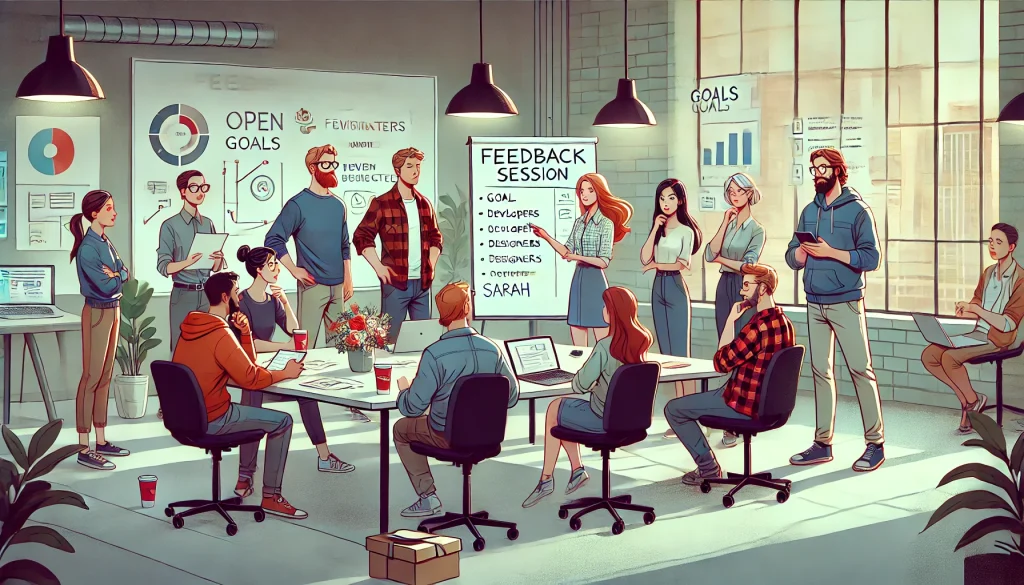Imagine a small tech startup on the verge of launching their first product—a mobile app designed to simplify personal finances. The team had been working tirelessly, but despite their efforts, progress seemed slower than expected. They had passionate developers, creative designers, and a visionary leader, but something was missing. Misunderstandings cropped up frequently, and some team members felt undervalued, while others felt overburdened. It became clear: they were struggling with a lack of feedback, and it was holding them back.
One day, Sarah, a team lead, decided to address the issue head-on. She called for a meeting and opened with an honest conversation. “We need to talk. I feel like we’re not communicating as well as we could, and that’s stopping us from being our best. What do you all think?” What followed was a revelation—everyone started sharing their frustrations, ideas, and hopes. It became obvious that the team needed something to pull them together, to help them grow collectively: a feedback loop.

The next day, Sarah introduced a simple but powerful plan. The team would establish regular feedback sessions, not just to critique work but to also recognize what was going well. These sessions would include every member, from the most junior developer to the CEO. Each person would give and receive feedback, celebrating strengths and constructively addressing areas for improvement. To make it comfortable, Sarah made sure everyone understood that feedback wasn’t a one-time thing but an ongoing practice, aimed at growth.
At first, it wasn’t easy. Some team members hesitated, afraid of sounding too harsh or too critical. But slowly, as the sessions became more frequent, people started opening up. Emma, a shy designer, began speaking up about the technical limitations she faced, and Daniel, the lead developer, took her feedback to rework parts of the app’s structure. In return, Emma complimented Daniel on his quick fixes and brilliant coding solutions, which made collaboration smoother.
Sarah also made sure to act on the feedback. When suggestions were made, she didn’t let them vanish into the void of conversation. The team tracked their feedback in shared documents, set clear goals, and revisited them in future sessions to see what progress had been made. This cycle created momentum.
The more the team engaged in feedback, the more they improved—not just technically, but in how they worked together. They felt safer to express ideas, and more cohesive in their efforts. They even started using a project management tool to streamline feedback on tasks in real time, which sped up their workflow and kept everyone on the same page.

Over time, their weekly feedback sessions transformed the team dynamic. They not only learned from their mistakes but also celebrated their wins. With each iteration, they became more efficient, more motivated, and more innovative. The app they had been struggling to build finally started coming together, and they hit their launch date with confidence. In the end, it wasn’t just the product that was a success—it was the team itself, stronger and more connected than ever before.
Key Highlights:
1. Feedback Loops Build Trust and Growth: Regular, structured feedback sessions created an environment where team members felt heard, valued, and empowered to improve.
2. Celebrate Strengths, Address Weaknesses: By focusing on both strengths and areas for growth, the team fostered a supportive culture that encouraged personal and professional development.
3. Open Communication is Crucial: Honest, transparent conversations about both the good and the bad allowed the team to align on goals and resolve issues before they became problems.
4. Action is Essential: Feedback only matters if it’s acted upon. Tracking feedback and following up with clear, measurable actions ensured that the feedback loop wasn’t just talk—it was a tool for real progress.
5. Feedback Encourages Innovation and Morale: By embracing a culture of continuous feedback, the team avoided stagnation, improved their performance, and maintained high morale, leading to success both in their product and in their collaboration.
Strong feedback loops, when embraced, can transform a struggling team into a high-performing unit, driving innovation, trust, and long-term success.

